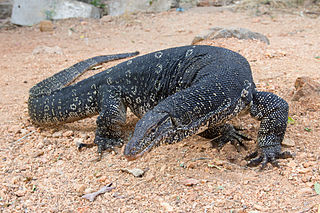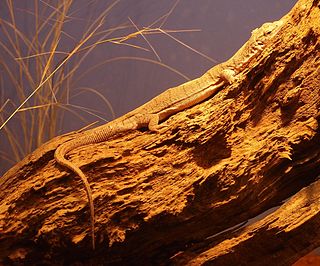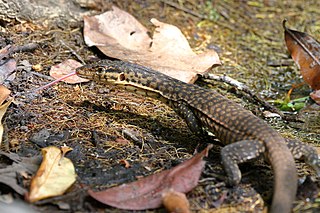
The Komodo dragon, also known as the Komodo monitor, is a member of the monitor lizard family Varanidae that is endemic to the Indonesian islands of Komodo, Rinca, Flores, and Gili Motang. It is the largest extant species of lizard, growing to a maximum length of 3 m (9.8 ft), and weighing up to 70 kg (150 lb).

Lizards are a widespread group of squamate reptiles, with over 7,000 species, ranging across all continents except Antarctica, as well as most oceanic island chains. The group is paraphyletic since it excludes the snakes and Amphisbaenia, although some lizards are more closely related to these two excluded groups than they are to other lizards. Lizards range in size from chameleons and geckos a few centimeters long to the 3-meter-long Komodo dragon.

Lizard Island is an island on the Great Barrier Reef in Queensland (Australia), 1,624-kilometre (1,009 mi) northwest of Brisbane and part of the Lizard Island Group that also includes Palfrey Island. It is part of the Lizard Island National Park. Lizard Island is within the locality of Lizard in the Cook Shire.

Agamidae is a family of over 550 species of iguanian lizards indigenous to Africa, Asia, Australia, and a few in Southern Europe. Many species are commonly called dragons or dragon lizards.

The earless monitor lizard is a semiaquatic, brown lizard native to the Southeast Asian island of Borneo. It is the only living species in the family Lanthanotidae and it is related to the true monitor lizards.

Monitor lizards are lizards in the genus Varanus, the only extant genus in the family Varanidae. They are native to Africa, Asia, and Oceania, and one species is also found in the Americas as an invasive species. About 80 species are recognized.

Megalania is an extinct species of giant monitor lizard, part of the megafaunal assemblage that inhabited Australia during the Pleistocene. It is the largest terrestrial lizard known to have existed, reaching an estimated length of 3.5 to 7 metres, and weighing between 97–1,940 kg (214–4,277 lb), but the fragmentary nature of known remains make estimates highly uncertain.

A goanna is any one of several species of lizard of the genus Varanus found in Australia and Southeast Asia.

The Bengal monitor, also called the common Indian monitor, is a monitor lizard distributed widely in the Indian Subcontinent, as well as parts of Southeast Asia and West Asia. This large lizard is mainly a terrestrial animal, and its length ranges from about 61 to 175 cm from the tip of the snout to the end of the tail. Young monitors may be more arboreal, but adults mainly hunt on the ground, preying mainly on arthropods, but also taking small terrestrial vertebrates, ground birds, eggs and fish. Although large Bengal monitors have few predators apart from humans who hunt them for meat, younger individuals are hunted by many predators.

The perentie is the largest monitor lizard or goanna native to Australia. It is one of the largest living lizards on earth, after the Komodo dragon, Asian water monitor, and the Crocodile monitor. Found west of the Great Dividing Range in the arid areas of Australia, it is rarely seen, because of its shyness and the remoteness of much of its range from human habitation. The species is considered to be a least-concern species according to the International Union for Conservation of Nature.

The Asian water monitor is a large varanid lizard native to South and Southeast Asia. It is one of the most common monitor lizards in Asia, ranging from coastal northeast India, Bangladesh, Sri Lanka, mainland Southeast Asia, and southern China to Indonesian islands where it lives close to water. It is listed as Least Concern on the IUCN Red List. It was described by Laurenti in 1768 and is among the largest squamates in the world.

The mangrove monitor, mangrove goanna, or Western Pacific monitor lizard is a member of the monitor lizard family with a large distribution from northern Australia and New Guinea to the Moluccas and Solomon Islands. It grows to lengths of 3.5 to 4 ft.

The yellow-spotted monitor, also known as the Argus monitor, is a monitor lizard found in northern and western regions of Australia and southern New Guinea.

The spiny-tailed monitor, also known as the Australian spiny-tailed monitor, the ridge-tailed monitor the Ackie's dwarf monitor, and colloquially simply ackie monitor, is an Australian species of lizard belonging to the genus of monitor lizards (Varanus).

Mertens' water monitor, also called commonly Mertens's water monitor, and often misspelled Mertin's water monitor, is a species of lizard in the family Varanidae. The species is endemic to northern Australia, and is a wide-ranging, actively foraging, opportunistic predator of aquatic and riparian habitats. It is named after German herpetologist Robert Mertens.

The pygmy mulga monitor, also known commonly as Gillen's monitor or just the mulga monitor, is a species of lizard in the family Varanidae. The species is endemic to Australia.

The Northern Sierra Madre forest monitor, also known by the local names bitatawa, baritatawa, and butikaw, is a large, arboreal, frugivorous lizard of the genus Varanus. The lizard is a distinctive food of the Aeta and Ilongot indigenous people of the Philippines.

Mitchell's water monitor is a semiaquatic species of monitor lizard in the family Varanidae. The species is native to Australia. The species is native to the Northern regions of Australia, and is on IUCN's Red List as a critically endangered species. They can be distinguished by the orange or yellow stripes along their neck and dark spots along their back. They are mainly carnivorous, and eat small prey such as lizard, birds, and insects.

Odatria, commonly known as dwarf monitors, consists of small monitor lizards found in Australia and Indonesia. Species in this subgenus include the smallest monitor species in the world, the tiny 16 gram Dampier Peninsula monitor, but also includes some more medium sized species such as the 240 gram black-palmed rock monitor.
Water goanna may refer to:


















